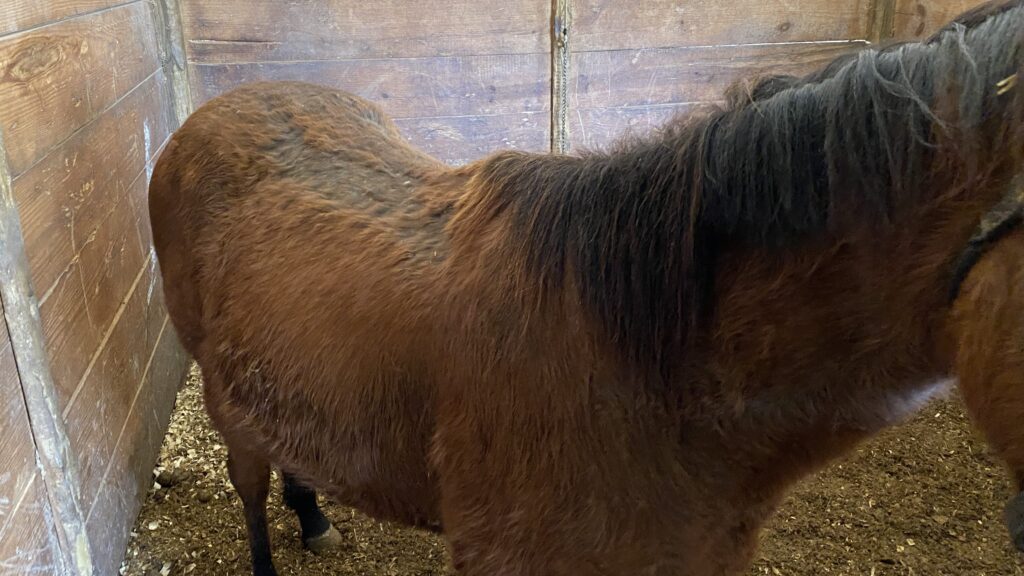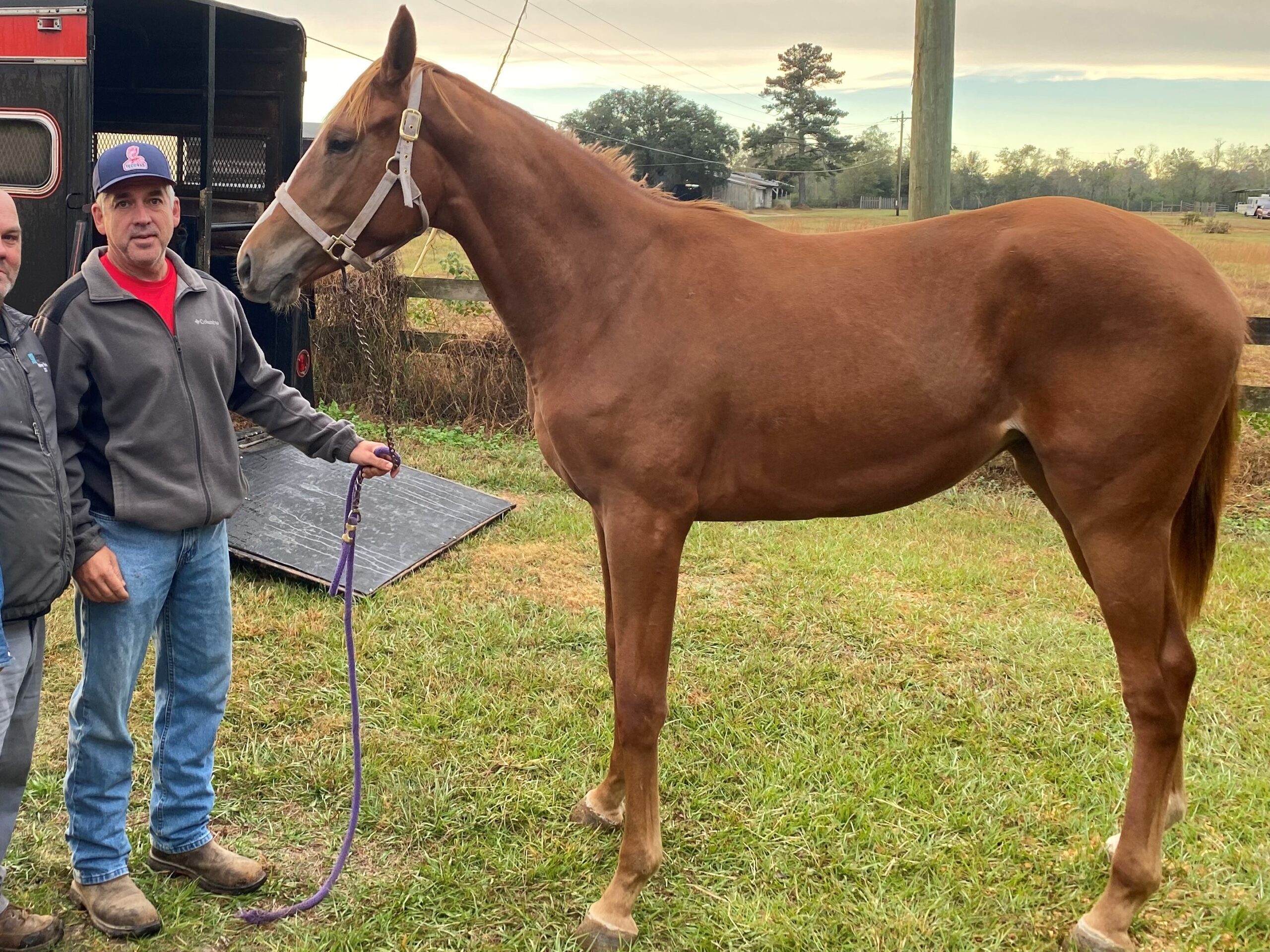Published on: December 11, 2024
Any links on this page that lead to products on Amazon are affiliate links and I earn a commission if you make a purchase. Thanks in advance – I really appreciate it!
A horse’s coat reflects its overall health. A glossy, vibrant coat signals vitality, while dullness or irritation often points to underlying issues. Various skin conditions can impact your horse’s coat, affecting their appearance, comfort, and well-being. This guide explores common horse skin conditions, their effects on coat health, and actionable solutions for prevention and treatment.

Rain Rot (Dermatophilosis): A Common Horse Skin Condition
Rain rot is a bacterial infection caused by Dermatophilus congolensis that thrives in warm, damp conditions. Prolonged exposure to moisture, such as from rain or sweat under blankets, creates an ideal environment for the bacterium to invade the outer layers of the skin, leading to characteristic symptoms. According to Penn State Extension, these conditions significantly increase the risk of rain rot.
Symptoms
Rain rot is characterized by:
- Crusty scabs with matted hair
- Painful lesions along the back, rump, and legs
- Hair loss and irritation

Impact on Coat Health
Rain rot results in patchy hair loss and scarring. Hair regrowth may be uneven, and untreated cases can lead to secondary infections that further compromise coat quality.
Treatment & Prevention
- Treatment: Gently remove scabs, clean with antiseptic solutions like Betadine or chlorhexidine scrub, and apply antibiotics for severe cases. Recovery typically begins within a week, with visible improvements in 2–3 weeks.
- Prevention: Keep horses dry, ensure proper blanket ventilation, and avoid prolonged exposure to wet environments. Rain rot is not extremely contagious between horses, but shared equipment or close contact in wet conditions can spread the bacteria.
I once rescued malnourished Thoroughbreds with severe rain rot. Gentle cleaning with antiseptic shampoos over several weeks restored their coats—and their spirits. With proper treatment and preventive measures, rain rot can be effectively managed, ensuring your horse’s coat remains healthy and vibrant.
Ringworm in Horses: A Fungal Skin Condition Explained
Ringworm is a highly contagious fungal infection caused by Trichophyton and Microsporum species. It spreads through shared grooming tools, tack, or bedding, as emphasized by UC Davis Veterinary Medicine. Warm, damp environments are particularly conducive to the spread of this fungus, making prevention and treatment critical for maintaining coat health.
Symptoms:
- Circular, scaly, hairless lesions
- Itching and rapid lesion spread
- Crusting and thickened skin in severe cases

Impact on Coat Health:
Ringworm disrupts the coat’s uniformity by leaving bald spots. If untreated, scarring may occur, resulting in permanent coat irregularities and making recovery more difficult.
Treatment & Prevention:
- Treatment:
- Apply topical antifungal medications such as miconazole or ketoconazole.
- Use oral treatments like griseofulvin for severe or widespread cases.
- Thoroughly disinfect grooming tools, tack, and bedding.
- Improvement is typically seen within 1–2 weeks, but consult a veterinarian if no progress is evident.
- Prevention:
- Isolate infected horses to prevent the spread of ringworm.
- Maintain strict hygiene in shared spaces by disinfecting with chlorhexidine-based products.
- Regularly inspect shared equipment and bedding for contamination.
Case Example:
I noticed a small circular lesion on one of my horses after borrowing a friend’s horse blanket during a cold spell. Recognizing it as ringworm, I immediately isolated the horse, cleaned the lesion with an antifungal solution, and washed all shared equipment thoroughly.
Early intervention and diligent hygiene measures ensured no other horses were affected in my barn. Addressing ringworm promptly protects not only your horse but also your herd’s overall health.
Sweet Itch in Horses: Managing Insect Bite Hypersensitivity
Sweet itch, caused by an allergic reaction to the saliva of Culicoides midges, is one of the most frustrating conditions for horse owners. The World Horse Welfare Organization emphasizes minimizing exposure to these insects to prevent outbreaks.
Symptoms:
- Severe itching along the mane, tail, and withers
- Hair loss, thickened skin, and scarring from scratching
- Open sores prone to infection

Impact on Coat Health:
Sweet itch results in significant hair loss, chronic irritation, and skin thickening if untreated. This condition dramatically affects both the horse’s appearance and comfort, making early intervention critical.
Treatment & Prevention:
- Treatment:
- Apply corticosteroids or antihistamines to reduce inflammation.
- Use medicated creams for sores to prevent infections.
- Horses typically show improvement within days, with significant results in a week.
- Prevention:
- Use fly sheets to protect sensitive areas.
- Apply effective insect repellents such as Pyranha Spray.
- Install barn fans to disrupt midge activity, as midges dislike air movement.
- Stabling animals at dawn and dusk reduces exposure to flies and midges.
- Consider adding fly traps or using insect-proof netting in stalls for additional protection.
Note: Consult your vet for severe cases before using corticosteroids.
Case Example:
One summer, my Thoroughbred filly started rubbing her tail against the fence post, eventually developing raw patches on her skin. Suspecting sweet itch, I immediately applied a corticosteroid cream and started using a fly sheet designed for midges.
I also added a fan in her stall and kept her inside during peak midge hours. Within a week, her condition improved dramatically. By addressing environmental factors and providing prompt treatment, you can effectively manage sweet itch and keep your horse comfortable.
Other Horse Skin Conditions and How to Address Them
Horses can experience a variety of skin conditions that impact coat health. Regular monitoring and swift intervention are key to minimizing damage and ensuring your horse stays comfortable and healthy.
Atopic Dermatitis
Chronic itching and redness caused by allergens.
- Treatment: Use antihistamines, corticosteroids, or allergen-specific immunotherapy as recommended by your veterinarian.
- Prevention: Use hypoallergenic bedding and minimize exposure to known allergens.
Prompt treatment and allergen management prevent prolonged discomfort and help maintain your horse’s coat integrity.
Contact Dermatitis
Inflammation from irritants like plants or chemicals.
- Treatment: Remove irritants and apply soothing ointments like Corona Cream. Improvement is usually noticeable within days.
- Prevention: Regularly inspect turnout areas and stabling for hazardous plants and chemicals.
Managing allergens and minimizing exposure to irritants is essential for reducing chronic skin issues and supporting a shiny, healthy coat.

Lice and Mites
Intense itching, dandruff, and hair thinning caused by parasites.
- Treatment: Apply topical treatments like Frontline Spray or Permethrin solution. Symptom relief typically begins within a week.
- Prevention: Clean and isolate infected horses and disinfect shared equipment to prevent spread.
Quick isolation and thorough cleaning of shared equipment can prevent widespread infestations, protecting your horse’s comfort and coat.

Sarcoids
According to the National Library of Medicine, equine sarcoids—the most common skin tumors in horses—are associated with bovine papillomavirus (BPV), though the exact role of BPV in their development is not fully understood.
- Treatment: The University of Minnesota recommends cryotherapy, surgical removal, or topical treatments like Aldara Cream (imiquimod). Recovery takes 4–6 weeks, with coat regrowth requiring months.
- Prevention: Regular skin inspections help detect sarcoids early, allowing for prompt treatment.
One of my Quarter Horses developed scaly patches and thinning hair near his neck. Suspecting lice, I immediately treated him with a Permethrin solution and thoroughly cleaned the grooming tools and tack.
Within a week, his condition improved dramatically, and none of my other horses were affected. Regular skin inspections can detect sarcoids in their early stages, ensuring timely treatment to prevent long-term coat damage and improve your horse’s comfort and overall health.

Grooming Tips for Preventing Horse Skin Conditions
Regular grooming not only maintains a healthy coat but also allows for early detection of skin conditions that could otherwise go unnoticed.
Frequency
- Daily: During shedding seasons, frequent grooming prevents matting, removes dead hair, and reduces the risk of skin irritation.
- Weekly: In winter, focus on high-risk areas like legs and under blankets where moisture can build up, leading to skin issues.
- Specific Conditions: Horses with existing skin problems may require more frequent grooming to remove irritants and support healing.
Tools & Techniques
- Curry Combs: Loosen dirt and debris while stimulating circulation and promoting healthy skin.
- Soft Bristle Brushes: Distribute natural oils, smooth the coat, and enhance its shine.
- Mane and Tail Combs: Detangle and remove debris without causing breakage.
- Inspections: During grooming, check for abnormalities such as scabs, bumps, bald spots, or excessive oiliness.
While grooming my horse last spring, I noticed hair loss around her eye. Concerned, I consulted my vet, who diagnosed a contact allergy. Early intervention with a topical treatment resolved the issue within days, underscoring how routine grooming can prevent larger problems.
Preventive Benefits
Grooming helps prevent skin conditions by removing dirt, sweat, and moisture that can lead to fungal or bacterial growth. Regular attention also reduces the risk of parasites like lice or mites. Grooming sessions also strengthen the bond between you and your horse, encouraging consistent care and early detection of health issues.
Grooming is a cornerstone of coat health, enabling early detection of issues before they worsen. Consistency and attention to detail during grooming sessions not only keep your horse looking its best but also safeguard its overall well-being.
The Role of Nutrition in Preventing Horse Skin Conditions
Proper nutrition is vital for coat health. Specific nutrients like omega-3 fatty acids, biotin, zinc, and copper play essential roles in supporting skin repair, hair growth, and overall coat quality. For an in-depth guide, visit our article on Horse Coat Nutrition: Tips for a Shiny, Healthy Coat.

Key Nutrients & Their Recommended Levels
- Omega-3 Fatty Acids:
- Found in flaxseed, fish oil, and supplements like SmartOmega 3 by SmartPak.
- Daily Requirement: Approximately 1-4 ounces of ground flaxseed or 1-2 tablespoons of flaxseed oil per day, depending on the horse’s weight and activity level.
- Biotin:
- Essential for hoof and coat health. Available in supplements like Farnam Horseshoer’s Secret.
- Daily Requirement: A minimum of 15-20 mg per day is recommended for visible improvements in coat and hoof quality.
- Zinc & Copper:
- Critical for hair growth and repair. Found in mineral supplements with balanced ratios (typically 3:1 zinc to copper).
- Daily Requirement:
- Zinc: 400-500 mg/day.
- Copper: 100-125 mg/day.
- Vitamin E:
- Supports skin elasticity, immune health, and coat shine. Found in vitamin E-enriched feeds or supplements.
- Daily Requirement: Horses require 1-2 IU per pound of body weight, with higher levels for active or stressed horses.
Practical Feeding Tips
- Add a tablespoon of flaxseed oil or a scoop of ground flaxseed to your horse’s daily feed to enhance coat shine.
- Include a high-quality mineral supplement designed for equines to ensure balanced zinc and copper levels.
- For older horses or those with dry skin, consider a vitamin E supplement to support skin and coat health.
Consult an equine nutritionist to tailor a diet that meets your horse’s specific needs. Proper nutrition improves your horse’s coat health and boosts its overall well-being and performance.
When to Consult a Veterinarian for Horse Skin Conditions

Seek professional advice if you notice any of the following symptoms in your horse:
- Persistent lesions or swelling: These may indicate underlying infections or skin conditions requiring medical treatment.
- Severe itching or hair loss: Could signal allergies, parasites, or other conditions needing veterinary intervention.
- Unusual growths or tumors: Early detection and diagnosis are crucial for effective treatment of potential skin tumors like sarcoids.
Example: A few months ago I noticed a lump on my horse’s neck. After consulting a veterinarian, it turned out to be a sarcoid that needed treatment. Acting early prevented complications and improved recovery.
For more information on equine health, visit the AAEP website.
Frequently Asked Questions about Horse Skin Conditions
Have questions about managing your horse’s skin health? Here are quick answers to some of the most common concerns horse owners face.
Can rain rot spread to other horses?
Rain rot is not directly contagious, but shared equipment or close contact in wet conditions can spread the bacteria. Keeping horses dry and disinfecting grooming tools can help prevent its spread.
Is ringworm in horses contagious to humans?
Yes, ringworm is zoonotic, meaning it can spread to humans through direct contact with an infected horse or contaminated equipment. Wearing gloves and washing hands after handling an infected horse is essential.
How can I prevent sweet itch in horses?
Minimize exposure to midges by using fly sheets, insect repellents, and barn fans. Keeping horses indoors during peak midge activity at dawn and dusk also helps.
How often should I groom my horse to prevent skin conditions?
Daily grooming is ideal, especially during shedding seasons, to remove dirt and irritants. Focus on high-risk areas like the legs and under blankets during winter.

Conclusion: How to Prevent, Treat, and Care for Horse Skin Conditions
A horse’s coat is a mirror of its overall health. To keep your horse looking and feeling its best:
- Groom Regularly: Consistent grooming removes dirt, sweat, and irritants, helping prevent fungal and bacterial infections while promoting early detection of issues.
- Provide Proper Nutrition: Include omega-3 fatty acids, biotin, zinc, and copper in your horse’s diet to support skin and coat health.
- Act Quickly: Address any skin condition promptly with appropriate treatment and preventive care to minimize discomfort and long-term effects.
- Stay Proactive: Regular inspections and a clean, dry environment are key to preventing common skin issues.
By combining diligent care with early intervention and a nutrient-rich diet, you can ensure your horse’s coat remains a shining testament to their health and vitality.
- Join the Conversation: Share your tips or stories about managing equine skin conditions in the comments below! Your experiences could help others in the community.
- Subscribe: Get the latest equine health insights delivered straight to your inbox. Stay informed and keep your horse in top condition.
- Explore More: Dive into our horse care checklist and guide for healthier, shinier coats.

About the Author: Miles Henry
Lifelong Horseman | Racehorse Owner | Published Author
Miles Henry brings over 25 years of hands-on experience training and owning Thoroughbred racehorses. Raised with Quarter Horses and Appaloosas, he’s spent a lifetime learning from horses—on the track, in the barn, and in the field. Today, he runs a small but successful racing stable in Louisiana and shares real-world insights on HorseRacingSense.com, helping horse owners, fans, and bettors navigate the sport with confidence.
📚 Books: View Miles’s books on Amazon »
🎧 Podcast Guest: Animal Tales Ep. 32 |
YouTube Interview
📩 Newsletter: Sign up for racing tips and horse care advice »
🔗 Follow Miles:
Twitter |
Facebook |
YouTube

